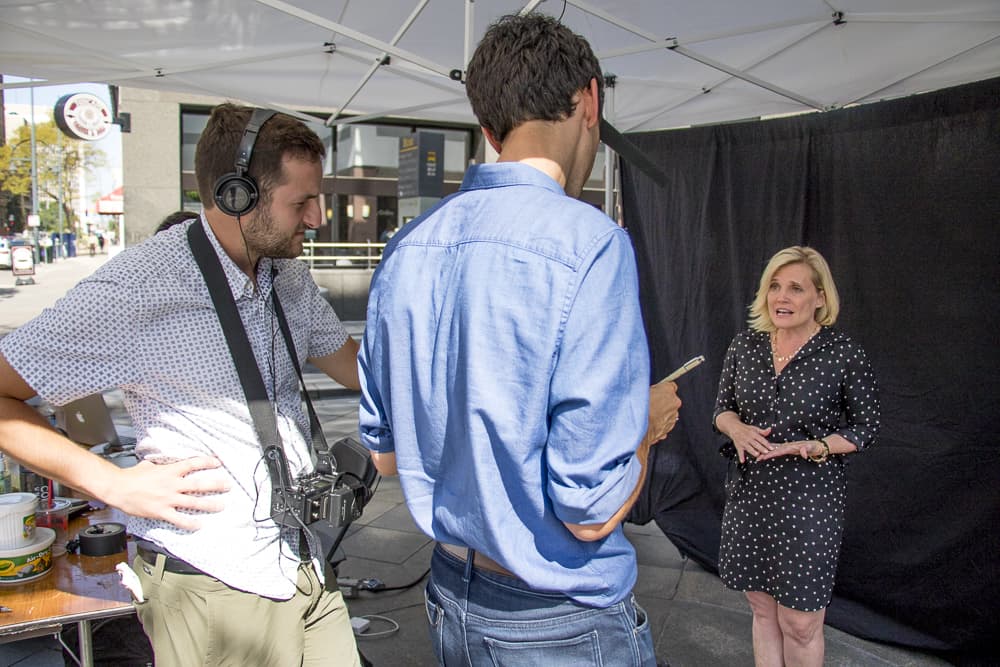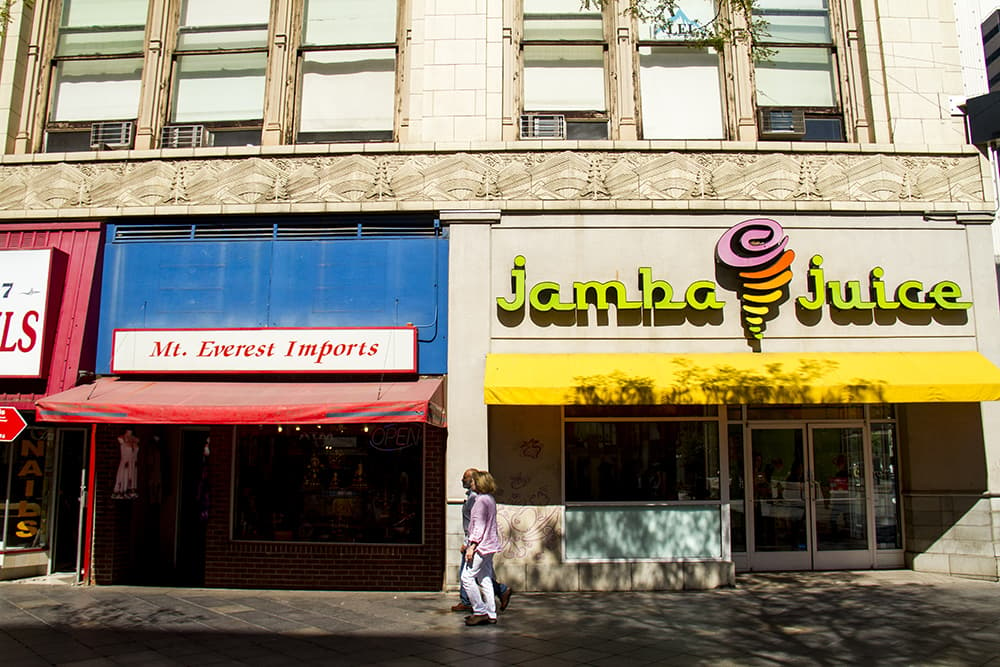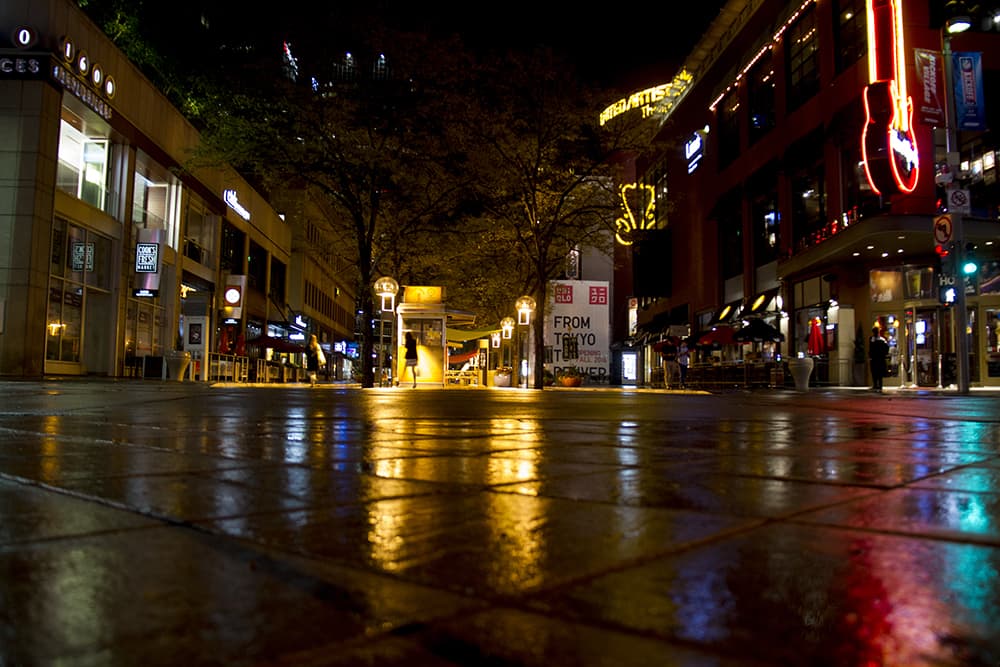
We’re drawing near a full workday spent on 16th Street Mall. (Read our journal here.) We’ve spoken to an absolute ton of people, sometimes enough to keep us busy for hours at a time. It's 6 p.m. and I have been completely overloaded, with people reminiscing and worrying and talking so much.
So, let’s start with the one who has some of the greatest influence over what happens to this stretch of Denver: Tami Door, president of the Downtown Denver Partnership.
What’s next for 16th:
Door came by at 3 p.m. for an interview, and we got to talking about how this central stretch of Denver might change. She said what’s coming will be an “evolution,” rather than some dramatic change.

“There isn’t necessarily one moment when 16th Street will be completely different,” she said.
One idea that has been floated, as she acknowledged: Drawing the bus lanes into the center of the corridor, and making the sidewalks much wider. (Walter Isenberg, owner of Sage Hospitality and chairman of the partnership, told us earlier that he liked this idea.) Another option: Have the bus run only in one direction on 16th Street, returning the other way on another street.
Can we get more local stores?
I asked Door about another of the frequent 16th Street complaints: It’s kind of “touristy.” Several people today told us that meant it didn’t have unique shops.

“Get Topo Designs out here. Get Huckleberry Roasters out here. Let’s find a way to get more Denver-ness, more Denver stores on 16th Street Mall,” said Lindsey, in her later 20s, one of our first visitors.
There doesn’t seem to be much of a push to change that. The popularity of the street means that “our vacancy is low, and our rents are high.” The Partnership wants to fill those storefronts with retailers that can continue to pay the bills, and that’s not necessarily going to be local retailers, according to Door.
“What we’re focused on is making sure they succeed,” she said citing the international–and-hip Uniqlo’s new presence as a big win.
Will the restaurants of the Lower Downtown side ever be open past 9 p.m.?
No promises. It’s hard to make 1.2 miles of mall “everything to all people,” Door said.

There are certain blocks primed for economic redevelopment, but Door wouldn’t tell which ones. You can get a pretty good guess through press coverage, she said.
Needless to say, the Downtown Denver Partnership is optimistic about the future of downtown Denver.
Notable quotables from the day, not said by Tami Door:
- “Pretty diverse, but it smells like pee.”
- “You can get into anything in the 16th Street Mall – anything.”
- “Rogues.” (In reference to “urban travelers.”)
- “I’m a geezer buzzard. When I was younger, I was just a buzzard.”
- “I feel like you have to provoke a person for them to mess with you.”
- “An ocean of social tides.”
- “Are you ready to have your mind blown?” - man wearing tuxedo T-shirt and top hat
How diverse is the Mall?
Very. This is obvious to anyone who has looked at the Mall: It has got to be the most racially and economically diverse mile of Denver.
Iris, 17, who is black, said that this mix can draw out some tensions that she didn’t see quite the same way in Georgia, where she grew up.
“I was walking out of T.J. Maxx … and on my way out a guy asked me, ‘Are you shopping for Kool-Aid?” she said. A comment like that changes your perception of a public space, she said.
She’s uncomfortable without friends and family – but she still loves the Mall. Generally, we found that young people saw the Mall as the place to be – kind of like, you know, a mall.
Does anyone miss the old 16th Street?
Why, yes.

“This is not Denver anymore,” said Sir, in his 50s, who used to drive low-riders on the Mall. “This is everyone wanting to smoke weed, coming to Denver … Some things are for the better, most for the worst.”
“This used to be traffic – this used to be westbound traffic. Then you got a bunch of people who wanted to move downtown, and putting lofts up. Once they moved in, they wanted to make rules.”
He said that a lot of what downtown is suffering from now is the loss of activities for young people. “They had three rollerskating rinks and one ice-skating rink,” he said.
“They don’t have anything for the youth to do. They don’t care about the youth. They don’t worry about it. They don’t have kids. They have a dog.”
OK, so what do people want from the Mall now?
One request that stuck with me: More recycling bins.
Also, more accessible water.
“More water features, more water fountains,” a guy named Dan May told us. "You see that guy sitting at the piano with his cats and the cat is panting. We need more water fountains for us and the cats."
Interestingly, the mall has a number of fountains (not the drinking kind), but some of them are out of commission because they no longer meet hygiene standards. I’d like the next water feature to be a lazy river, actually.
How’s security?
A security guard told me that his first summer on the job has been rough. The light rail stations on the Mall tend to attract large crowds, with fights and drug dealing, in the evenings. Things tend to be much calmer during the day.
People who spent the most time on the Mall – as in, homeless people and security – were obviously more likely to have seen violence. Joey, 22, was a couple months out of homelessness himself.
He spent a couple weeks loitering on the Mall before a shop manager offered him a job that got him housed and stable, he said. He had no sympathy for those still on the streets, and blamed them for the violence that happens at night.
“Trying to walk home, drunk as fuck, you get assaulted by homeless people,” he said.
There was a generally murky desire to stop homelessness. A few people suggested that unemployed people should be paid to clean the place. Craig, my first visitor of the day, thought that we should just sweep people out.
“I would get rid of all the loiterers, people with the signs. I know there’s laws and amendments, all this stuff. I’d get rid of them all.”
Lindsey was pretty frank about being annoyed by homeless people, but she was thinking about ways to change it too.
“If I’m having coffee or eating on a patio, there’s never been a time that I haven’t been approached,”
“I think we need to make people busy. Giving them jobs to pick up trash, because the city is dirty as shit - give them a potato sack to fill up a bag,” she said. “But I don’t want to direct them anywhere else … Try to come up with a solution to help these people make money.”
Personally, I’m excited about the electric buses.
That’s because I have been sitting directly between two bus lanes for about 10 hours. I don’t know if this is biasing me, but I feel like the Mall will be a lot less stressful – and it can be stressful – once the noise pollution is cut down.
Actually, the authorities are trying to figure out whether these new buses shouldn’t be a little louder. People already step in front of the loud ones.
That's enough for today. I'll be reflecting a lot more, and we'll have more coming, over the next little while.











